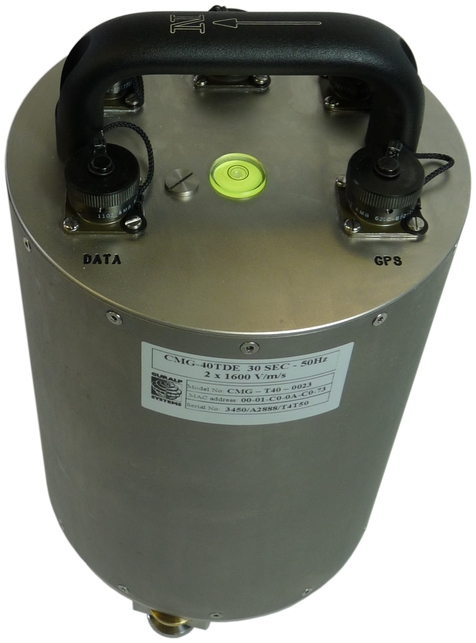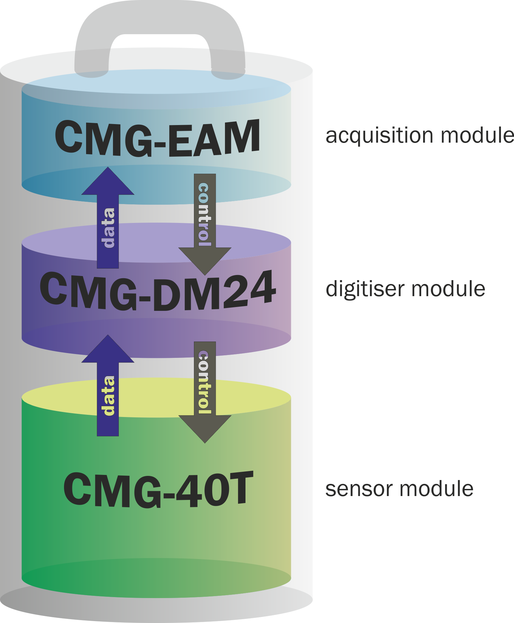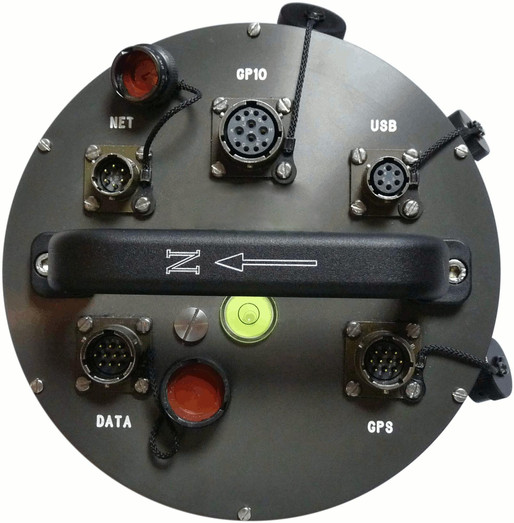
Chapter 1. Introduction
The Güralp 40TDE seismometer is a three-axis, broad-band, force- feedback seismometer packaged together with a 24-bit digitiser and a flexible data acquisition and storage unit, all in a single sealed case. The entire system is self- contained except for its power supply.
The 40T system combines low-noise components with high feedback loop gain to provide a linear, precision transducer with a large dynamic range.

The Güralp 40TDE has a rugged, waterproof stainless steel design for ease of installation. The lightweight sensor elements are designed so that no mechanical clamping is required. Because of this, the 40T is ready to record ground movements as soon as you provide it with power. In addition, the sensor does not have to be levelled or centred as long as the base is within 3 ° of horizontal. For the best results, however, you should install where possible on a hard, near-horizontal surface well coupled to the bedrock.
The Güralp 40TDE consists of three internal modules, the 40T sensor, an integrated digitiser and an integrated data acquisition system

The integrated digitiser is a Güralp DM24, a low-noise, 24-bit ADC module specifically designed for seismic data. The built-in digital signal processor (DSP) provides simultaneous, multiple sample-rate data streams at user-selectable rates. Up to 6 streams of data for each component are available at sample rates from 1 to 1000 samples/s. A precision microprocessor-controlled time-base synchronizes the analogue-to-digital converters to the DSP and provides time-stamps for data. A separate microprocessor system handles configuration and sensor control, including mass centring and calibration.
The integrated data acquisition system is a Güralp EAM, which provides serial and Ethernet communications, along with a convenient web-based interface to all functions, including digitiser and sensor configuration and control. It can act as a data recorder as well as a protocol converter and communications controller. Based around the powerful and stable Linux operating system, the Güralp EAM offers unrivalled flexibility, even including the ability to run user-installed scripts.
Each instrument is delivered with a detailed calibration sheet showing its serial number, measured frequency response in both the long period and the short period sections of the seismic spectrum, sensor DC calibration levels, and the transfer function in poles/zeros notation.
1.1 Connections
The Güralp 40TDE has five connectors on the top panel, the uses of which are described in this section.

1.1.1 DATA
The DATA port is the power input and also a general-purpose serial port. It is a command line terminal running at 115,200 Baud in the default configuration but it can also be used for GCF output (suitable for serial connection to Scream!) , PPP network connections, in-bound GCF (from a digital instrument, for example), NMEA functions, TCP serial conversion, a modem answering service or as a recorder to store and forward data from any instrument with a serial output.
1.1.2 NET
The NET port is a 100BASE-TX Ethernet connection. The supplied cable supports connection to a hub, switch or router. If direct connection to a PC or laptop is desired, an optional cross-over cable can be ordered.
1.1.3 GPIO
The GPIO (General Purpose Input/Output) port fulfils three functions: it provides a serial console to the EAM, which can be used for monitoring, configuration and control; it provides USB access from a PC or laptop to the internal FLASH storage for data collection (Use of this feature is described in the EAM manual, MAN-EAM-0001 ) and it provides a number of tri-state lines which can be used to control or monitor external equipment. One application is as tamper detection lines, which can be connected to external switches and monitors as part of a secure installation.
1.1.4 USB
The USB port allows connection of an external USB storage device for data collection. It is also possible to perform firmware upgrades using this port in situations where internet access is not available.
1.1.5 GPS
The GPS port allows connection of a GSL GPS receiver for use as a timing source for time-stamping seismic data. An additional serial port, ttySA2, is also available on this connector. It can be used for any of the functions listed above (in section 1.1.1).